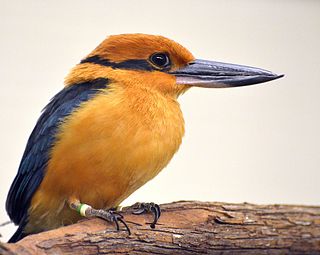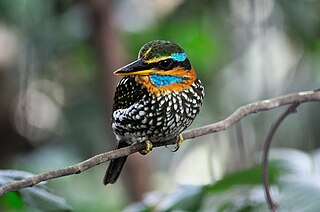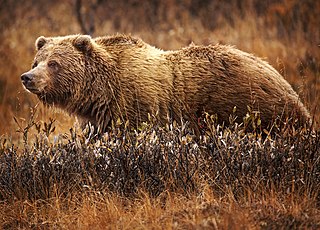Related Research Articles

The frogmouths (Podargidae) are a group of nocturnal birds related to owlet-nightjars, swifts, and hummingbirds. Species in the group are distributed in the Indomalayan and Australasian realms.
The National Audubon Society is an American non-profit environmental organization dedicated to conservation of birds and their habitats. Located in the United States and incorporated in 1905, Audubon is one of the oldest of such organizations in the world. There are completely independent Audubon Societies in the United States, which were founded several years earlier such as the Massachusetts Audubon Society, Indiana Audubon Society, and Connecticut Audubon Society. The societies are named for 19th century naturalist John James Audubon.

The Guam rail is a species of flightless bird in the Rallidae family, endemic to the United States territory of Guam. It is known locally as the ko'ko' bird. It was extirpated from the entire island by the late 1980s owing to the predation of the brown tree snake, an invasive species not native to the island.

The Canadian Wildlife Service or CWS, is a Branch of the Department of Environment and Climate Change Canada, a department of the Government of Canada. November 1, 2012 marked the 65th anniversary of the founding of Service.

The Wildlife Conservation Society (WCS) is a 501(c)(3) non-governmental organization headquartered at the Bronx Zoo in New York City, that aims to conserve the world's largest wild places in 14 priority regions. Founded in 1895 as the New York Zoological Society (NYZS), the global conservation organization is now led by Interim President and CEO Robb Menzi as of April 2, 2024. WCS manages four New York City wildlife parks in addition to the Bronx Zoo: the Central Park Zoo, New York Aquarium, Prospect Park Zoo and Queens Zoo. Together these parks receive 4 million visitors per year. All of the New York City facilities are accredited by the Association of Zoos and Aquariums (AZA).

Choiseul Island, native name Lauru, is the largest island of the Choiseul Province, Solomon Islands, at 7.08°S 157°E. The administrative headquarters of Choiseul Province is situated in the town of Taro, on Taro Island.

The Guam kingfisher is a species of kingfisher from the United States Territory of Guam. It is restricted to a captive breeding program following its extinction in the wild due primarily to predation by the introduced brown tree snake.
The Solomons frogmouth, also known as the Cinnamon frogmouth or Solomon Islands frogmouth, is a bird in the frogmouth family. It was first described in 1901, but not recognized as a distinct species until 2007. The Solomons frogmouth is the only known member of the genus Rigidipenna. It is also endemic to the islands of Isabel, Bougainville and Guadalcanal in the Solomon Islands archipelago, in the countries of Papua New Guinea and the Solomon Islands.

The marbled frogmouth is a bird in the family Podargidae. The species was first described by Jean René Constant Quoy and Joseph Paul Gaimard in 1830. It is found in the Aru Islands, New Guinea and Queensland. Its natural habitats are subtropical or tropical moist lowland forest and subtropical or tropical moist montane forest.

The moustached kingfisher, also called Bougainville moustached kingfisher, is a species of bird in the family Alcedinidae. It is endemic to Bougainville Island in Papua New Guinea. An estimated 250–1,000 mature individuals are left.

The spotted wood kingfisher or spotted kingfisher is a species of bird in the family Alcedinidae. It is endemic to the Philippines where its natural habitat is subtropical or tropical moist lowland forests.

eBird is an online database of bird observations providing scientists, researchers and amateur naturalists with real-time data about bird distribution and abundance. Originally restricted to sightings from the Western Hemisphere, the project expanded to include New Zealand in 2008, and again expanded to cover the whole world in June 2010. eBird has been described as an ambitious example of enlisting amateurs to gather data on biodiversity for use in science.

Ceyx is an Old World genus of river kingfishers. These kingfishers are found from South East Asia to the Solomon Islands.
David William Steadman is a paleontologist and ornithologist, and Curator Emeritus of ornithology at the Florida Museum of Natural History at the University of Florida.
Robert E. Beck Jr. was a zoologist and conservationist, who worked to save Guam's indigenous native birds from 1982 to 2003. Beck championed the fight to save Guam's native birds, such as the Mariana crow, rufous fantail, Guam flycatcher, Guam kingfisher and the Guam rail, known locally as ko'ko' in Chamorro, which are under the extreme threat of extinction due to the non-native brown tree snake and habitat loss. The rufous fantail and the Guam flycatcher listed above are now extinct in the wild in their native Guam. However, the captive and wild populations of the Mariana crow, Guam rail and the Micronesian kingfisher have increased, due in large part to conservation efforts by Beck.

The grizzly bear, also known as the North American brown bear or simply grizzly, is a population or subspecies of the brown bear inhabiting North America.

Strisores, sometimes called nightbirds, is a clade of birds that includes the living families and orders Caprimulgidae, Nyctibiidae (potoos), Steatornithidae (oilbirds), Podargidae (frogmouths), Apodiformes, as well as the Aegotheliformes (owlet-nightjars) whose distinctness was only recently realized. The Apodiformes and the Aegotheliformes form the Daedalornithes.

Chris Morgan is a British-born ecologist, conservationist, TV host, filmmaker, podcaster, and author. His ecology and conservation work focuses on bears and other large carnivores worldwide. Over the last 25 years Morgan has worked as a wildlife researcher, wilderness guide, and environmental educator on every continent where bears exist.

Douglas H. Chadwick is an American wildlife biologist, author, photographer and frequent National Geographic contributor. He is the author of fourteen books and more than 200 articles on wildlife and wild places.
The Guadalcanal moustached kingfisher is a kingfisher in the subfamily Halcyoninae that is endemic to Guadalcanal in the Solomon Islands. The bird can be found in closed-canopy forests at elevations of 900–1,100 m (3,000–3,600 ft), and is reported to nest in holes in the ground. It is considered a subspecies of the moustached kingfisher by the International Ornithologists' Union but some taxonomists elevate the taxon to species status.
References
- 1 2 "Chris Filardi: 'Scientist at Work' (The New York Times)". Bowdoin Daily Sun. 21 October 2010. Retrieved 26 June 2018.
- ↑ "Chris Filardi (faculty bio)". American Museum of Natural History.
- ↑ Silber, Emily (29 September 2015). "Moustached Kingfisher Photographed for First Time". Audubon . Retrieved 26 June 2018.
- 1 2 3 Johnson, Kirk Wallace (15 June 2018). "The Ornithologist the Internet Called a Murderer". The New York Times.
- ↑ Filardi, Christopher E. (7 October 2015). "Why I Collected a Moustached Kingfisher The field biologist who has spent 20 years working in the Solomon Islands explains the reasoning behind his decision". Audubon Magazine. Retrieved 15 June 2018.
- ↑ Kaplan, Sarah; Moyer, Justin William (12 October 2015). "A scientist found a bird that hadn't been seen in half a century, then killed it. Here's why". Washington Post. Retrieved 15 June 2018.
- ↑ "Até que Darwin os separe". Folha de S.Paulo. 5 July 2009. ProQuest 336235015.
- ↑ Lynch, Brendan (2 November 2016). "New research will create a 21st-century tally of biodiversity in Southwest Pacific". University of Kansas. Retrieved 26 June 2018.
- ↑ "New genus of bird found in South Pacific". United Press International. 19 April 2007. ProQuest 467668428.
- ↑ Cleere, Kratter, Steadman, Braun, Huddleston, Filardi and Dutson. 2007. A new genus of frogmouth (Podargidae) from the Solomon Islands – results from a taxonomic review of Podargus ocellatus inexpectatus Hartert 1901. Ibis149:271-286
- ↑ Braun, David Maxwell (26 January 2009). "White-eye Birds Are On Evolution Fast Track". National Geographic. Archived from the original on June 26, 2018. Retrieved 26 June 2018.
- ↑ Lee, Jane J. (22 July 2014). "First Nation Tribe Discovers Grizzly Bear "Highway" in Its Backyard". National Geographic. Archived from the original on July 26, 2014. Retrieved 26 June 2018.